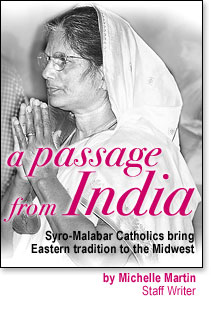 |
 |
|||||
 |
 |
 |
 |
 On any given Sunday, more than 700 people—mostly natives of Kerala,
India, and their families— drive from across the Chicago area
to attend Mass at Mar Thomas Shleeha Church in Bellwood, the Syro-Malabar
Mission of the Archdiocese of Chicago. On any given Sunday, more than 700 people—mostly natives of Kerala,
India, and their families— drive from across the Chicago area
to attend Mass at Mar Thomas Shleeha Church in Bellwood, the Syro-Malabar
Mission of the Archdiocese of Chicago.They come to worship in Malayalam, their native language, according to the rite they grew up with. While the basics of the Mass would be familiar to any Latin-rite Catholic, there is more music, more color and more incense. The prayers are longer and more musical, and Communion is offered by intincture, with the consecrated host dipped into the consecrated wine. Women come dressed in their Sunday finest—colorful saris or long tunics over trousers. Men generally wear slacks and open-collared shirts. Starting July 1, they will no longer be a mission church of the archdiocese. Cardinal Varkey Vithayathil, major archbishop of the Syro-Malabar Catholic Church, will establish the new St. Thomas Syro-Malabar Diocese of Chicago and consecrate Father Jacob Angadiath, director of Mar Thomas Shleeha, as its bishop. Two other bishops from India will concelebrate the Mass, with another 11 or 12 expected to attend. Cardinal George will give the homily. The ceremonies will take place at the Syro-Malabar Catholic Convention of America at the Hyatt Regency O’Hare. The convention runs June 30-July 3. Bishop-designate Angadiath, 55, will lead a diocese that includes the entire United States, and will serve Syro-Malabar Catholics in Canada as the permanent apostolic visitor. “I think it must be the largest diocese in the world,” Angadiath said, after celebrating Mass June 17. “I never thought I would be a bishop, or be a bishop in the U.S. But when the Holy Father made a request like that, I couldn’t say no. I will try, with the help of God.” His appointment was announced March 13. The diocese includes between 70,000 and 100,000 Syro-Malabar Catholics, mostly concentrated around large cities where they have come to work. Those who can often drive to the nearest of eight U.S. Syro-Malabar centers to worship, although many worship in Latin-rite parishes in their neighborhoods. Many Syro-Malabar Catholics come to their own church whenever possible because they can feel at home there, Angadiath said. “It’s important that we have a diocese for the organized practice of our faith,” Angadiath said. The rite has a long heritage. Believers trace the origin of the Syro-Malabar Church to St. Thomas the Apostle, whom they believe traveled to the Kerala coast of India and converted many members of the upper castes to Christianity before being martyred. Other Eastern Christians, who first arrived from Eastern Syria in the fourth century, then influenced the church. It connected with the Latin-rite church in the 16th century, under the influence of Portuguese colonization, and it was not until the late 19th century that Indian bishops were appointed to lead the church. The church now has 24 dioceses in India, where there are more than 3 million Syro-Malabar Catholics: 12 in Kerala and 12 in other Indian states. The St. Thomas diocese is the first Syro-Malabar Diocese outside of India. According to Vatican II documents, where enough Catholics of other rites gather in Latin-rite jurisdictions, provisions should be made for their own parishes, and, if there are enough of them, their own dioceses. Chicago had the first Syro-Malabar center in the United States, a center which found a home in the former St. John Crysostom Church. “In the Latin-rite churches, we are far behind,” Angadiath said, noting that Syro-Malabar Catholics rarely take leadership roles or even participate fully in parish life, whether because of language barriers or unfamiliarity with the culture. At Mar Thomas Shleeha, they not only can worship, they can join Bible study and prayer groups, sign up their children for religious education and Malayalam classes and participate in any of several charitable and religious societies. The church will host the Syro-Malabar Catholic Convention of America June 30-July 3 at the Hyatt Regency O’Hare, an event featuring the establishment of the new diocese and the new bishop, along with a full schedule of workshops, seminars and devotions. Young people will have their own sessions, mostly conducted in English. In fact, creating an American English translation for youth Masses tops Angadiath’s list of challenges. Most children understand Malayalam fairly well, but their language of choice is English, he said. An English translation of the Mass used in India does not work well for children in America, so he wants to create his own, he said. The church offers Malayalam classes for the children, but the religious education classes are offered in English, said Jose Nadakapadam, the former director of religious education for the church. “We try to keep the heritage,” Nadakapadam said. “Even if they can’t speak Malayalam, they can usually follow it.”
For more information about the Syro-Malabar Church, visit thesyromalabarchurch.org. For information about Mar Thomas Shleeha Church, visit members.aol.com/smalabar/index.htm Front Page | Digest | Cardinal | Interview |